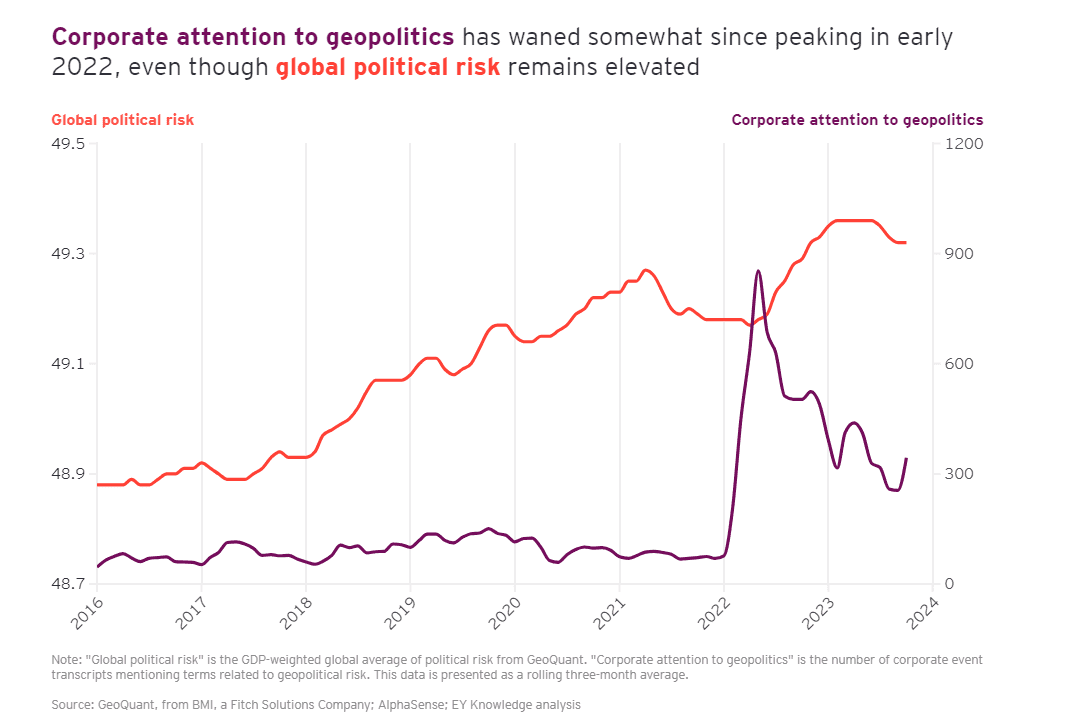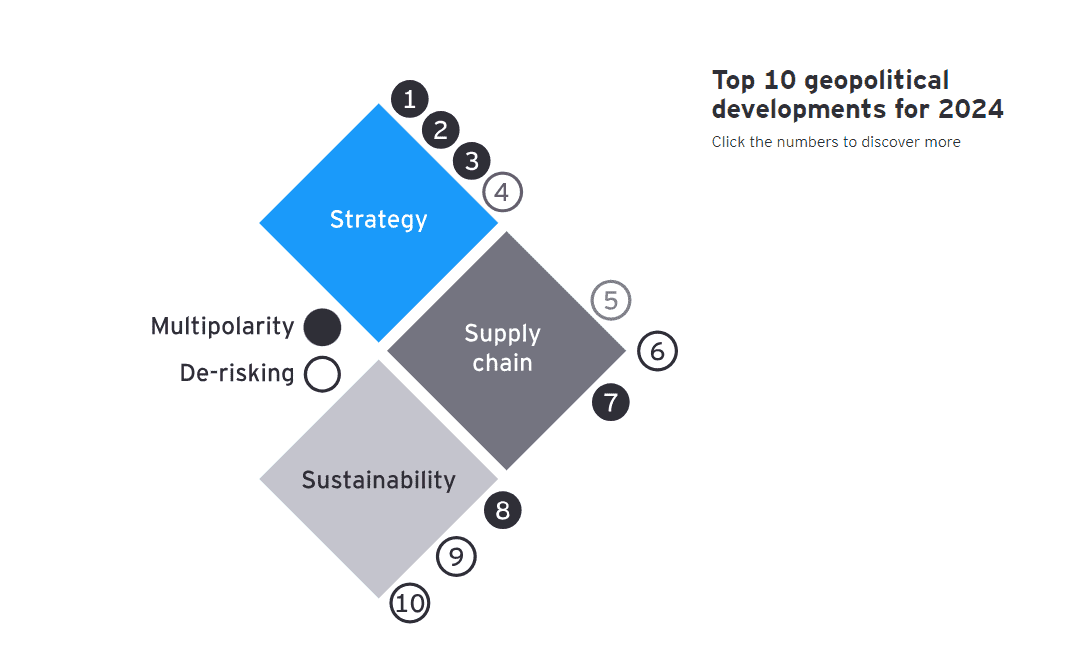The global elections supercycle will contribute to geopolitical complexity. Businesses need to adapt their strategies to stay ahead.
In brief
- In 2024, artificial intelligence and the oceans will emerge as new issues motivating geopolitical competition and regulatory dynamics.
- To thrive in this new era, companies need to adjust their business models, strategies, supply chains and sustainability plans.
- The EY Geostrategic Business Group has released the 2024 Geostrategic Outlook, which examines how geopolitics will affect business in the year ahead.
Geopolitics in 2024 will be volatile and unstable. Before digging into the 2024 Geostrategic Outlook (pdf), let’s first look back at the past year. How closely did the expectations in the 2023 Geostrategic Outlook align with reality?
The annual Geostrategic Outlook presents analysis by the EY Geostrategic Business Group (GBG) on the global political risk environment in the year ahead.
To select the top 10 geopolitical developments in the 2024 Geostrategic Outlook, the GBG first conducted a crowdsourced horizon scanning exercise to identify potential political risks. The crowdsourced inputs came from dozens of subject matter resources across EY teams, including those focused on public policy, strategy, macro trends and sector-level developments across all geographical regions. This scan encompassed the four categories of political risk in the geostrategy framework — geopolitical, country, regulatory and societal — throughout all regions of the world. The GBG then identified additional developments through interviews with subject matter resources in other political risk organizations.
Next, the GBG assessed all the identified political risks along two dimensions: their probability of occurring and the degree to which they would have impact on companies across sectors and geographies globally. This impact assessment is aligned with the second step in implementing a geostrategy. The top 10 geopolitical developments included in this Outlook are those that were assessed to be both high probability and high impact, broadly speaking for global companies.
The past year was yet another in which businesses faced an extraordinary collection of geopolitical events and deepening trends. Many geopolitical developments unfolded largely as we expected. “Stabilized volatility” – one of the overarching themes we identified in our 2023 Geostrategic Outlook – proved an apt description of geopolitical tensions and government intervention in economies persisting and plateauing at an elevated level. However, geopolitical tensions began to rise again in the fourth quarter, particularly in the Middle East – a region that we had not included in our top 10 developments for 2023.
Our second overarching theme from 2023 also stood the test of time: governments around the world faced a variety of “policy trade-offs.” Among the most consequential and dynamic policy areas has been energy security and associated sustainability concerns. Climate policy continues to reign near the top of the agenda for many governments, culminating in the recent 2023 United Nations Climate Change Conference (COP28) in the UAE. However, central banks and fiscal policymakers managed the inflation-recession paradox better than had been expected. And we did not foresee how rapidly generative artificial intelligence (AI) would emerge, so it was a surprise that regulation of AI jumped to the top of the agenda.
Looking ahead, many of the themes and developments from 2023 will continue to play out in 2024.
Navigating a Multipolar World
One defining feature of the geopolitical environment in 2024 will be multipolarity. A greater number of powerful actors will shape an increasingly complex global system. As great powers, the EU, the US and China will continue to shape the global operating environment in profound ways. Geopolitical swing states – countries such as India, Saudi Arabia, Turkey, South Africa and Brazil that are not specifically aligned with any major power or bloc – will gain more sway over the international agenda.

Smaller countries and non-state actors will also seize on opportunities to redraw boundaries or otherwise shape their corner of the geopolitical multiverse. The war in Ukraine and geopolitical conflicts that have flared up in several other parts of the world may only be the beginning.
De-risking Global Supply Chains
The second defining feature of geostrategy in 2024 will be de-risking. The COVID-19 pandemic and the war in Ukraine highlighted countries’ global dependencies and the challenges in achieving resilience with just-in-time and globalized supply chains – especially when production was concentrated in a small number of markets.
Governments have responded by reengaging in or expanding their reliance on industrial policy. They are seeking to promote greater domestic production of critical products. In certain markets, geopolitical competition has already been embedded with these industrial policies. We will see more of this explicit connection between economic policy and foreign or national security policies in the year ahead.
Countries Race to Iinnovate on and Regulate AI
Building on its momentum in 2023, the geopolitics of AI will become more important in 2024. Governments will race to regulate AI to reduce the potential of sociopolitical risks. But policymakers will simultaneously try to foster domestic AI innovation to compete geopolitically. As a result, AI will be a central dynamic in US-China relations. In 2024, the dual races to innovate and regulate AI will accelerate the shift toward distinct geopolitical blocs.
Oceans take Geostrategic Prominence
But 2024 will also be different in several important ways. The geopolitics of the oceans will feature more prominently in the global zeitgeist. The oceans are home to 94% of all life on our planet, and they are an increasingly important economic and national security resource. A staggering 90% of global goods trade is shipped via maritime routes, but many of the world’s busiest maritime transit corridors are at risk of geopolitical disruption. And deep-sea mining is forecast to account for at least one-third of the supply of critical minerals necessary for the energy transition. Companies will need to take ocean geopolitics into account when setting their supply chain and sustainability strategies
Elections Everywhere All at Once
And 2024 will be a year of elections – we call it the global elections supercycle. Voters will go to the polls in markets accounting for about 54% of the global population and nearly 60% of global GDP. This will generate regulatory and policy uncertainty in the short and medium term. We may look back on some – especially the US and EU – as the most consequential elections in decades, amid competing visions for international relationships and economic policy that will fundamentally impact the global business environment.
The 2024 Geostrategic Outlook
Current events muddy the geopolitical outlook and raise the risk of more significant conflict escalation in the year ahead. But what is crystal clear is geopolitics has become a multiverse: a complex mix of alliances and rivalries, with overlapping bilateral, regional and other types of institutional groupings. These dynamics, coupled with more countries heading to the polls in 2024 than in any year in recent history, elevate the likelihood of geopolitical surprises in 2024 – on both the downside and the upside.
The geopolitics surrounding AI and the oceans are just two of the top 10 geopolitical developments in the 2024 Geostrategic Outlook. The EY Geostrategic Business Group selected these developments because they are most likely to have significant impacts on organizations across sectors and geographies in 2024. As executives seek to anticipate and plan for geopolitical disruptions, two key themes will be important to keep in mind in 2024. The first theme is multipolarity, as geopolitical power becomes more dispersed amid heightened competition between blocs or alliance networks. The second is de-risking, with countries’ policy stances seeking to reduce global dependencies, prioritizing national security (broadly defined) over purely economic considerations.

Strategy
1. The geopolitical multiverse – The growing influence of geopolitical swing states and smaller players seeking to change the status quo will create a more complex multiverse. Companies should realign their global footprint and corporate strategy to fit a multipolar geopolitical landscape.
2. Geopolitics of AI – The dual races to innovate and regulate AI will accelerate the shift toward distinct geopolitical blocs. Companies need to develop business models and technology strategies around AI that account for different regulatory approaches across markets.
3. Domestic challenges in the US and China – Political risks are heightened within each market and could have knock-on effects for geopolitics and global growth. Companies should factor internal challenges in the US and China, as well as their impact on other countries exposed to these two markets, into corporate strategies.
4. Global elections supercycle – Multiple upcoming elections worldwide will generate regulatory and policy uncertainty, with long-term implications for industrial strategies, climate policies and ongoing military conflicts. Companies need to conduct scenario analysis to explore the potential impacts.
Supply Chain
5. Prioritizing economic security – Economic security measures to “de-risk” global interdependencies will be a prime tool in geostrategic competition. Companies should assess whether parts of their supply chains are strategic to governments now or will be strategic in the future and adapt their supply chain strategy accordingly.
6. The diversification agenda – Value chain diversification will pose both upside and downside political risks for companies entering or expanding in alternative markets. Companies should rethink their supply chain strategies and potentially expand production capacity and supplier relationships in new markets.
7. Geopolitics of the oceans – Competition over the world’s oceans will intensify in 2024, with implications for supply chains, data flows, food supplies and energy security. Companies should build resilience to the potential impacts of maritime shipping insurance rate increases, shipment delays or damaged cargos and vessels.
Sustainability
8. Competition for commodities – Geopolitical competition will intensify to secure supplies of critical minerals, food and water. Companies need to analyze current and future access to renewable energy and water in markets around the world, as well as the potential for public attention to their water and energy usage.
9. Dual track green policies – The national goals of economic growth and energy security will drive countries’ climate policies. Companies should incorporate policy-driven risks and opportunities into sustainability agendas, while staying ahead of the regulatory curve globally.
10. Climate adaptation imperative – Even as policymakers strive to mitigate climate change through emissions reductions, the urgency of adapting to the current physical risks of climate change will come into sharper focus. Companies should explore opportunities for investing in nature-based solutions and other adaptation initiatives.
The top 10 geopolitical developments in the 2024 Geostrategic Outlook will have broad-based impacts on companies across sectors and geographies. But each development is likely to have more direct impacts on certain sectors and sub-sectors, particularly in the near to medium term.
Advanced manufacturing and mobility – Economic security policies are likely to provide growth and investment opportunities for manufacturers. But the competition for commodities will affect the price and availability of critical inputs.
Consumer products and retail – Climate policies may provide opportunities for consumer companies to invest in this space. But the risk of geopolitical tensions disrupting critical shipping lanes could raise shipping costs and insurance rates.
Energy and resources – Dual track green policies will affect business models and strategies across the entire sector. Competition for commodities will pose risks and opportunities to miners, utilities and biofuels producers.
Financial services – Economic security and the diversification agenda are affecting banks’ and insurers’ global footprints and strategies. And the geopolitical multiverse will affect foreign exchange rates and currency markets.
Government and infrastructure – The global elections supercycle will in many cases slow the policymaking agenda. And elections systems will be at risk of foreign interference via cyberattacks, misinformation campaigns, or financial operations.
Health sciences and wellness – Economic security policies may affect companies’ global footprints and supply chains. The geopolitics of AI will affect companies that are exploring how to harness AI to transform healthcare.
Private equity – Economic security is likely to create opportunities to finance investments and launch more local start-up funds. The geopolitics of AI and the climate adaptation imperative will affect funds’ investment theses.
Technology, media and telecommunications – Economic security policies will affect the investments and sales of semiconductor manufacturers and telecommunications companies. Data centers’ high energy use could come under scrutiny.
A visual illustration of how the top 10 geopolitical developments in the 2024 Geostrategic Outlook may impact certain sectors and sub-sectors. The sectors and predicted impacts are:
- Advanced manufacturing and mobility – Economic security policies are likely to provide growth and investment opportunities for manufacturers. But the competition for commodities will affect the price and availability of critical inputs.
- Consumer products and retail – Climate policies may provide opportunities for consumer companies to invest in this space. But the risk of geopolitical tensions disrupting critical shipping lanes could raise shipping costs and insurance rates.
- Energy and resources – Dual track green policies will affect business models and strategies across the entire sector. Competition for commodities will pose risks and opportunities to miners, utilities and biofuels producers.
- Financial services – Economic security and the diversification agenda are affecting banks’ and insurers’ global footprints and strategies. And the geopolitical multiverse will affect foreign exchange rates and currency markets.
- Government and infrastructure – The global elections supercycle will in many cases slow the policymaking agenda. And elections systems will be at risk of foreign interference via cyberattacks, misinformation campaigns or financial operations.
- Health sciences and wellness – Economic security policies may affect companies’ global footprints and supply chains. The geopolitics of AI will affect companies that are exploring how to harness AI to transform healthcare.
- Private equity – Economic security is likely to create opportunities to finance investments and to launch more local start-funds. The geopolitics of AI and the climate adaptation imperative will affect funds’ investment theses.
- Technology, media and telecommunications – Economic security policies will affect the investments and sales of semiconductor manufacturers and telecommunications companies. Data centers’ high energy use could come under scrutiny.
Three Steps to Take to Thrive Amid the Complexity
Multipolarity and de-risking will pose both challenges and opportunities for companies around the world. Each of the developments explored in the 2024 Geostrategic Outlook will affect companies in unique ways and will therefore necessitate specific geostrategic actions to capitalize on the opportunities they present while also mitigating the risks they pose. At a high level, there are three no-regrets geostrategic moves that companies should take.
1. Build geopolitical considerations into business models and strategies.
In this era of profound change in the international system, the importance of geopolitics to corporate strategy is at its highest level in a generation. Successfully weaving geopolitical dynamics into corporate strategy will increasingly be a competitive advantage.
2. Increase the resilience of global supply chains.
Many companies’ supply chains are exposed to geopolitical developments. Executives need to determine how they can better position their company’s operating model and supply chain strategy to proactively adjust and increase their resilience to geopolitical disruptions.
3. Adapt sustainability strategies to geopolitical realities.
Multipolarity and de-risking are influencing government approaches to policies regarding climate change and natural resources, which will affect companies’ sustainability requirements, costs, competitive opportunities and strategy. Executives should incorporate new policies and regulations, as well as signals for how such policies may evolve in the future, into their sustainability strategies.
Summary
Global executives seeking to anticipate and plan for geopolitical disruptions should keep two key themes of multipolarity and de-risking in mind in 2024. There are three pivotal steps to take to get ahead of the top developments coming in the next year.
The article was first published here.
Photo by GeoJango Maps on Unsplash.

 5.0
5.0 













